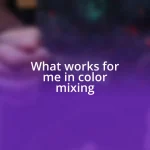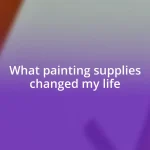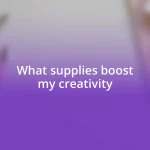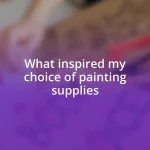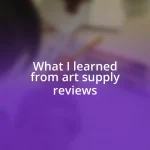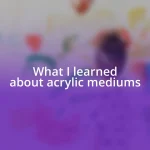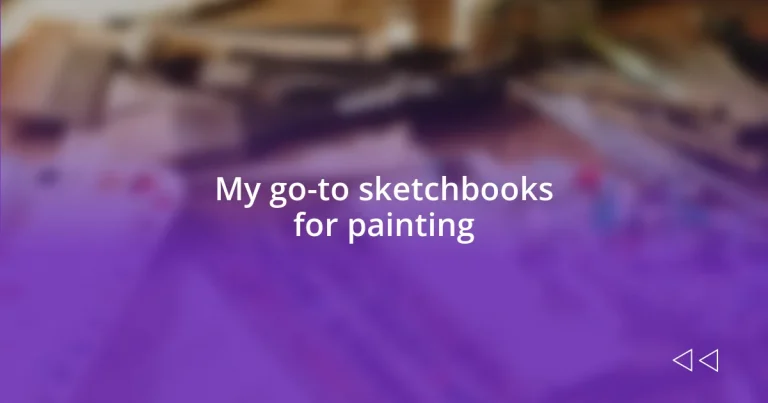Key takeaways:
- Choosing the right sketchbook involves considering paper weight, size, and binding type to enhance your creative process.
- Different types of sketchbooks (watercolor, mixed media, canvas-bound) cater to various artistic needs and mediums.
- Personal recommendations include Stillman & Birn for versatility, Hahnemühle for luxurious quality, and Art Alternatives for affordability and durability.

Choosing the right sketchbook
When I choose a sketchbook, I always consider the weight and texture of the paper. I remember the first time I picked up a sketchbook with 300 gsm paper—it felt like heaven under my brush. Have you ever had that moment when the paper just allows your creativity to flow effortlessly?
It’s also essential to think about the size of your sketchbook. I’ve had experiences where I brought a small sketchbook along on a trip, thinking, “This will be perfect for on-the-go!” But then, I found myself wishing I had a larger canvas to capture the stunning landscapes I encountered. What’s your preference—do you like the compactness of a small book, or do you crave the freedom of larger pages?
Lastly, binding plays a crucial role in your overall experience. I often gravitate towards spiral-bound sketchbooks because they lay flat easily, which is a lifesaver when I’m working on an intricate design. Have you ever struggled with a book that just wouldn’t stay open? It’s frustrating and can interrupt your creative flow. The right binding can make a world of difference in how comfortably you can work.
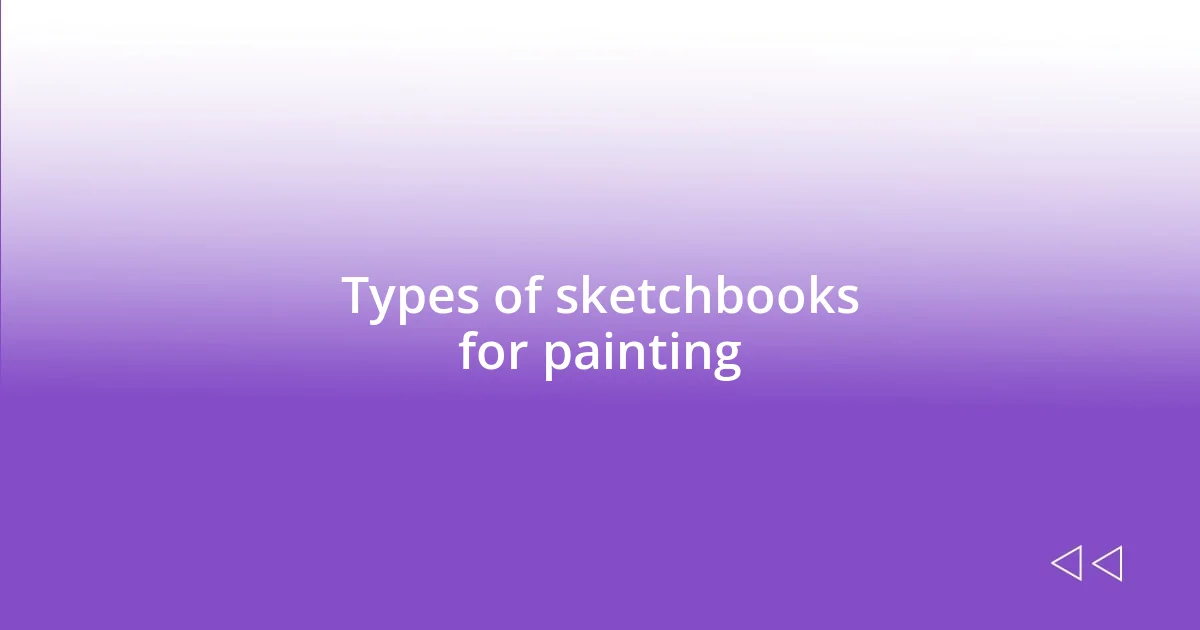
Types of sketchbooks for painting
There are various types of sketchbooks for painting, each catering to different artistic needs and preferences. For those who enjoy working with watercolors, I recommend opting for watercolor sketchbooks specifically designed to withstand moisture. These usually feature heavyweight, textured paper that helps prevent warping, which can be a game changer! I recall a time when I used a standard sketchbook for my watercolor practice and ended up with pages that curled and buckled. It was a frustrating experience that taught me the importance of the right paper.
If you prefer mixed media or like to dabble in various materials, mixed media sketchbooks are an excellent choice. They often have versatile paper that can handle everything from ink to acrylic paints. I once purchased a mixed media sketchbook on a whim, and I was amazed at how well it handled even my most intense acrylic experiments. The paper felt sturdy and flexible, allowing me to express myself without fear of damage. Do you have a favorite medium? Choosing the right sketchbook can elevate your practice based on what you enjoy most.
Lastly, don’t overlook the classic canvas-bound sketchbooks. They are perfect for those who love a traditional feel while painting. The smooth surface often mimics that of stretched canvas, making it ideal for oils and acrylics. I still remember the first time I painted on canvas paper, thinking it would replicate the experience of a larger canvas. The portability and ease of use were incredible, allowing me to capture spontaneous moments of inspiration wherever I was.
| Type | Features |
|---|---|
| Watercolor | Heavyweight, textured paper; prevents warping. |
| Mixed Media | Versatile paper for various materials; sturdy and flexible. |
| Canvas-Bound | Traditional feel; smooth surface mimicking stretched canvas. |

Features to consider in sketchbooks
When selecting a sketchbook, I always pay close attention to the paper’s weight and texture, as they can significantly affect the final outcome of my work. I once picked up a sketchbook that didn’t match my preferred medium, and it was disheartening to see my vibrant colors bleed into each other. That experience taught me that the feel of the paper beneath my brushes can inspire a different type of creativity, sometimes even leading to unexpected artistic choices or, even better, happy accidents!
Here are some features that I consider essential when choosing a sketchbook:
- Paper Weight: Look for at least 200-300 gsm for heavier mediums.
- Texture: Smooth paper is great for fine details, while textured paper suits watercolor and mixed media.
- Size: Larger sizes are beneficial for expansive creativity, but smaller options allow for portability.
- Binding Type: Consider spiral-binding for ease or perfect binding for a more polished look.
- Paper Color: White paper enhances colors, while toned paper can provide interesting contrast.
I learned early on that a sketchbook’s binding could also influence my creative flow. During an outdoor painting session, I found myself battling with a perfect-bound sketchbook that kept flipping shut every time I leaned over it. Frustrated, I switched to my trusty spiral-bound book, and the difference was night and day—it stayed open, allowing me to focus entirely on capturing the scene around me. It’s in those little but significant details that the right sketchbook becomes not just a tool, but a companion on the creative journey.
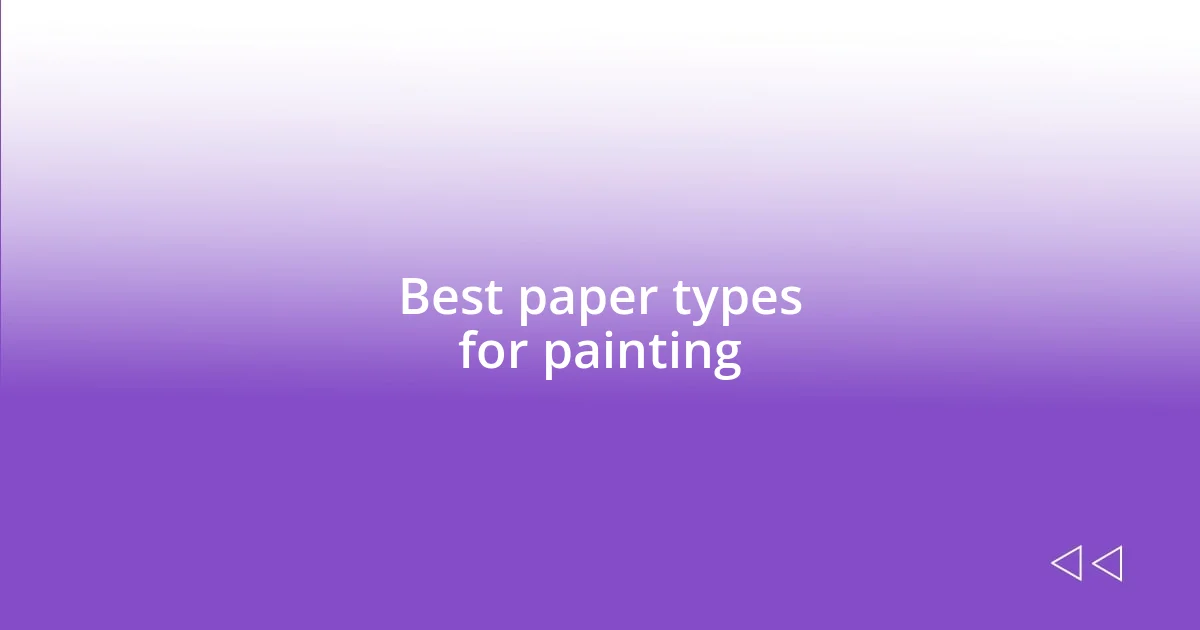
Best paper types for painting
When it comes to paper types for painting, I’ve discovered that not all paper is created equal. For instance, I have a particular fondness for cold-press watercolor paper. It has that delightful texture that holds water beautifully, allowing colors to flow and blend. I still remember the first time I worked with it; my paints danced across the page in a way I had never experienced. Don’t you love that moment when everything just clicks in your creative process?
On the flip side, I also find hot-press watercolor paper captivating for its smoothness. It’s ideal for fine details and precision work, especially when I’m painting intricate designs or portraits. I once attempted a detailed flower study on hot-press paper, and the results were striking. The way the colors leapt off the page was almost euphoric! That experience showed me the spectrum of artistry you can achieve by simply changing your paper choice.
I can’t overlook the charm of heavier cardstock for acrylics and pastels. Not only does it provide a robust surface, but it offers a satisfying grip that I love. One time, during a vibrant abstract painting session, I reached for a thick cardstock that held up beautifully to my bold strokes and layered techniques. I felt empowered knowing the paper wouldn’t buckle under the pressure, which freed my creativity to soar! Have you found a paper type that really enhances your artistic expression?

Top brands of sketchbooks
When it comes to sketchbooks, a few brands consistently catch my eye. I have a soft spot for Moleskine; their sleek design and high-quality paper just elevate my creative process. I remember getting my first Moleskine sketchbook and feeling an almost instant connection—its pages cradled my thoughts and sketches effortlessly. Each turn of the page felt like unwrapping a gift, all ready to be transformed into something beautiful.
Another standout for me is Strathmore. Their mixed media sketchbooks are a delight. On one occasion, I experimented with different acrylic washes, and the way the paper handled moisture was impressive. I’ve gone through several of their 400 series since then because they inspire confidence in my bold strokes. Have you found a particular brand that just seems to resonate with your style?
Lastly, I can’t overlook the appeal of Canson. Their watercolor sketchbooks are a constant in my art bag. I vividly recall a sunny afternoon at the park, painting water lilies with a Canson watercolor book in hand. The paper soaked up my paint, allowing for soft washes and vibrant colors to blend beautifully. The experience felt like a conversation with nature itself! Have you ever felt that connection to the materials you use? It’s one of the most fulfilling aspects of painting.
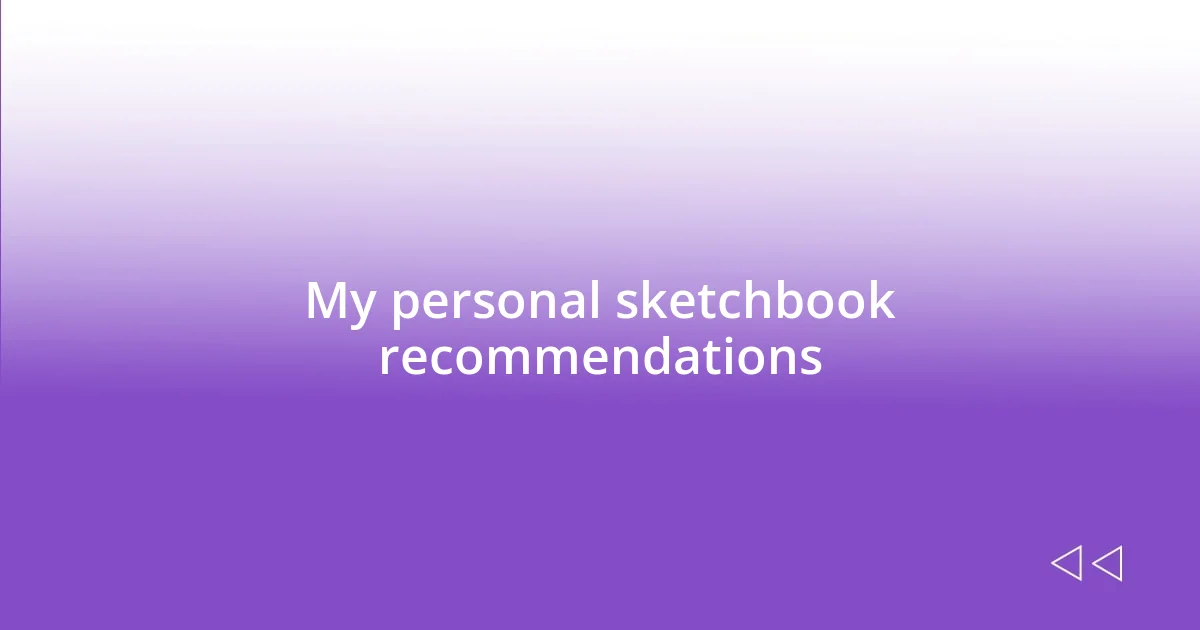
My personal sketchbook recommendations
When it comes to my personal sketchbook recommendations, I can’t help but rave about the Stillman & Birn sketchbooks. Their Alpha series has been a game changer for me, specifically because the pages can handle both wet and dry media. I remember the first time I tried to create a mixed-media piece; the paper just took everything I threw at it, from watercolors to ink, and remained smooth. Have you ever experienced that magical moment when your materials harmonize perfectly?
Another favorite of mine is the Hahnemühle sketchbook, which I adore for its luxurious paper quality. There was a time when I was sketching outdoors, and the way the fine texture captured my pencil lines was delightful. I vividly recall the excitement I felt seeing how the colors from my watercolor pencils came to life on those pages. It made me wonder—how often do we overlook the impact that paper quality has on our creativity?
Lastly, I have to mention the Art Alternatives sketchbooks, known for their durability and affordability. During one intense art weekend, I went through multiple artworks, and these sketchbooks stood strong through each layer of paint. I found comfort in knowing I could experiment freely, without fear of tearing or buckling. Isn’t it reassuring to have materials that empower you to push your boundaries?

Tips for using your sketchbook
When working in my sketchbook, one of my top tips is to let go of perfection. I often remind myself that each page is a playground for experimentation. I recall a day when I doodled random shapes that, over time, evolved into a full-color abstract piece. How liberating it was to realize that not every sketch needs to be a masterpiece!
Another practical approach I’ve found helpful is to dedicate specific pages for particular subjects. For instance, I once set aside a section just for color studies, where I mixed various hues and shades. The joy of flipping back to those pages and seeing my progression inspires me to continue exploring. Have you considered structuring your sketchbook in a way that emphasizes areas you want to develop?
Lastly, always carry your sketchbook with you. I learned this the hard way during a long train journey when an unexpected sunset unfolded outside my window. I had no art supplies, just a blank sketchbook, and I felt a pang of regret for missing that moment. Since then, I keep a compact set of watercolors and brushes handy, ready to capture inspirations as they arise. How often do you find opportunity in the mundane? Those moments can become vibrant memories in your sketchbook!
